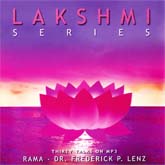
Lakshmi Series
The Tibetan Rebirth Process
The Tibetan Rebirth Process. With the advent of the books of W. Y. Evans-Wentz and Alexandra David-Neel, the peoples of Europe and the United States began to catch their first glimpse of the spirit of the land of Tibet.
Up until that time Tibetan yoga was relatively unknown in the West, and as W. Y. Evans-Wentz and Alexandra David-Neel began to publish accounts of their journeys to those snowy regions, a small but steadily growing flame of interest was propagated among persons who seek spiritual answers and insights into the workings of the cosmos. Both Wentz and Neel went to Tibet, associated with Tibetan lamas and themselves were initiated into basic forms of Tibetan yoga, and I certainly recommend their books highly for colorful insights into these processes.
However, neither Wentz nor Neel either claimed to be or was enlightened. Both were seekers on the path and what they tried to do was present the ancient wisdom of the Tibetan Buddhists, primarily through the translation of the ancient Tibetan documents. These translations were made by monks they had associated with, and many people have come to read these documents, particularly the well-known Tibetan Book of the Dead, and assumed that their readings of these documents has given them an entrance into the mystery of Tibetan yoga. It is my position, however, that most uninitiated persons who have read these documents have probably been more confused by them than enlightened by them. So what I would like to attempt to do in the next hour is to talk with you about Tibetan yoga, as it was practiced hundreds of years ago.
Tibetan yoga is founded on several principle ideas. The first idea, of course, is that all human beings are part and parcel of consciousness, that consciousness is existence itself, and that consciousness has a field of attention through which it becomes aware of different participles of reality - or eventually it becomes fully conscious of all of existence, which is, as you know, what we call enlightenment; that there are specific ways that this enlightenment takes place, in other words, enlightenment isn't an accident, it's rather a science; that there are other universes other than our universe, universes not so much in the physical world as universes of mind, of spirit; that all of the universes operate through specific types of laws and once you've learned and mastered these laws you can operate in and through these different universes; and that you are capable of uniting yourself with the void, with eternity.
The Tibetan Book of the Dead has to do with the rebirth process. The Book of the Dead discusses the various bardos. The bardos are the intermediate planes of existence that occur between death and rebirth. The Tibetan Book of the Dead is often used, or certainly was used in recent times, after the advent of death. When a person would die, a monk would come, or a family member, and for several days they would read from The Book of the Dead with the feeling that the spirit of the deceased would be able to hear the reading. The Book of the Dead is really a TripTik, it's a AAA Guide, a road map, through the nonphysical dimensions. The belief of course that surrounds it, or that underlies it, is that all creatures and beings in the phenomenal universe are on a giant wheel, the wheel of birth and death, and that at the end of each lifetime you die and you will be reborn in another world.
The Tibetans believe that there are six primary bardos or worlds into which you can attain rebirth. In each of these bardos or worlds, or lokas, there are countless subworlds. The earthly plane is an intermediate world, it's kind of in the middle of the six. The six are seen as a circle. Very often if you look at a Tibetan thangka, or Tibetan art, you'll notice that there's a symbol of the wheel of life. It's a big circle and it's divided into six quadrants. Usually at the top of the circle will be the world of the Buddhas, of the enlightened ones. At the bottom of the circle there will be the hell worlds. There will be other worlds, four other worlds; usually there's a world for the angels and saints, a world that reflects the consciousness of the animals and several others. Each of these worlds is a state of mind, a state of existence.

